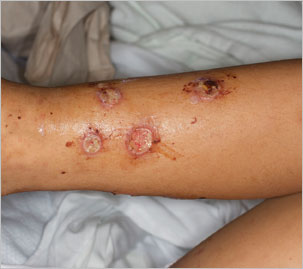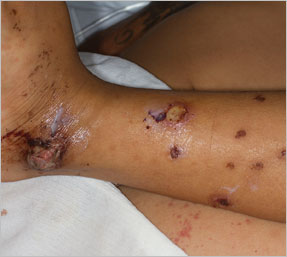An unusual case with which to challenge your senior residents (and staff)

A 5-year-old male was admitted to the hospital for evaluation of several progressive problems, including an unusual rash, swollen joints, abdominal pain and hematochezia, for the last 23 days. He was diagnosed with Henoch-Schönlein purpura, or HSP, on day 2 of the illness during a 24-hour hospital stay, and discharged for outpatient follow-up. However, the rash persisted and spread upward from the legs, and some lesions took on a more necrotic, ulcerative appearance, with no evidence of blistering, while other areas were blotches of erythema. The arthritis and arthralgias improved, but the abdominal pain persisted with periodic blood seen in the stools. His past medical history was that of a previously healthy 5-year-old male. His immunizations were up to date, and he had no travel or sick contacts.



Source: James H. Brien, DO
Examination revealed normal vital signs and a child in moderate distress with some cutaneous discomfort, with numerous discrete, foul-smelling, open, ulcerative skin lesions restricted to the lower extremities, and a perianal lesion (Figures 1 to 3). There were also some patches of erythema on the thighs, with a few widespread patches on the upper body. The mouth had a whitish, plaque-like lesion about the right tonsil and hypopharynx. There were no other mucous membrane lesions, and the joints appeared normal. The abdominal exam and genitourinary areas were also normal.
Lab tests revealed a CBC with a WBC count of 20 and 724,000 platelets, a CRP of 29, an erythrocyte sedimentation rate of 24, and a normal complete metabolic profile. Two of the ulcerative lesions were swabbed and Gram-stained, which revealed mostly Gram-positive cocci and a few Gram-negative rods. Cultures grew multiple organisms, including Staphylococcus aureus (MSSA), group A strep and Streptococcus anginosus group. A skin biopsy showed leukocytoclastic vasculitis with focal IgA and C3 complex deposition on immunofluorescence (IgA vasculitis). Endoscopy with biopsies was normal.
What’s your diagnosis?
A. Pyoderma gangrenosum (PG)
B. Persistent HSP
C. Bullous impetigo (BI)
D. Answers A and B
Case Discussion
This turned out to be D, a case of persistent, symptomatic HSP, with classic biopsy findings, as well as associated PG (both A and B). There appears to only be one case report of this association in the literature, that of a 16-year-old male reported in June 2017 from Istanbul, Turkey, in the Medical Bulletin Haseki. Coincidentally, the patient presented above was diagnosed in the same month as the referenced case report. While it is not unusual to see discrete central necrosis of skin lesions associated with HSP, these large, ulcerative, “gangrenous” lesions seen in this case are not typical. The diagnosis of PG is largely observing a typical lesion with recognition of a coincident underlying disorder involving the immune system, and the exclusion of other ulcerative conditions. About 50% of cases have been associated with underlying inflammatory disorders, such as inflammatory bowel disease, rheumatoid/autoimmune disorders, malignancies, and others, but the association with HSP was not previously recognized. A thorough evaluation for these various underlying conditions in our patient was unremarkable, and the child had an unremarkable recovery. Additionally, the term “pyoderma gangrenosum” is a misnomer; it is neither a pyogenic process nor gangrenous. However, there may be a secondary infection that can complicate the lesion.
HSP is well recognized as a classic pediatric condition but uncommon (approximately 10 per 100,000 per year), with the vast majority occurring between 3 and 16 years of age. The four hallmark features include:
1.Palpable purpura without thrombocytopenia and coagulopathy

2.Arthralgia and/or arthritis
3.Abdominal pain
4.Renal disease
The diagnosis is made by recognizing the rash and other clinical features. In less obvious cases, a skin biopsy will reveal the typical IgA small vessel vasculitis. Rarely, the course can be complicated by renal insufficiency or prolonged abdominal pain. It is fairly common for children to have arthralgia and arthritis. In fact, in my experience, the arthritis is very common and often helps secure the diagnosis. Treatment is of unproven benefit except in the case of severe, prolonged abdominal pain, which favors using steroids. The intestinal involvement may result in intussusception. Therefore, significant abdominal pain should have a low threshold for obtaining an ultrasound.
BI is a discrete cutaneous infection, caused by a strain of S. aureus, usually a phage group II strain, which produces an epidermolytic toxin locally, resulting in the formation of a blister or bullous lesion at the site of the infection only. While the culture of one of the lesions grew S. aureus, as well as group A strep and S. anginosus group, and there may have been a low-level infection of individual lesions, the lesions were not bullous (Figure 4) but rather ulcerative.
- Reference:
- Duru NS, et al. Med Bull Haseki. 2017;doi:10.4274/haseki.3369.
- For more information:
- James H. Brien, DO, is with the department of infectious diseases at McLane Children’s Hospital, Baylor Scott & White Health, Texas A&M College of Medicine in Temple, Texas. He also is a member of the Infectious Diseases in Children Editorial Board. Brien can be reached at jhbrien@aol.com.
Disclosure: Brien reports no relevant financial disclosures.
